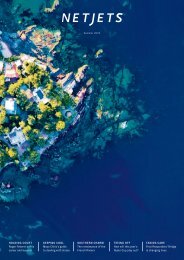Create successful ePaper yourself
Turn your PDF publications into a flip-book with our unique Google optimized e-Paper software.
RYAN YOUNG<br />
Fittingly, for one of the most significant and pioneering collections of media art in the world, the Kramlich Collection is not standing<br />
still. Since Pamela and Richard Kramlich (above, at their residence) focused their attention on new media in the late 1980s they have<br />
cultivated a body of work that now encompasses over 200 films, videos, slides, and installations, as well as over 250 significant works<br />
of photography, sculpture, painting, and drawing by more than 230 artists from around the world. Major players featured in these include<br />
Marina Abramović, Steve McQueen, and Andy Warhol. Having amassed such a notable collection, the next step in the journey was to<br />
build an establishment capable of presenting a series of works that, according to the Kramlichs, “lived and breathed, that was disruptive,<br />
and that placed a complex set of demands on its installation, in terms of space, light, scale, sound, and time.” This involved both working<br />
with artists to establish how best to display their work and a near-20-year collaboration with the architects Herzog & de Meuron, which<br />
resulted, in 2016, in the magnificent Kramlich Residence. Located amid the beauty of Napa Valley, the 8,000 square feet of galleries<br />
allow visitors—tours are invite-only—to view the collection at a pace dictated by the works themselves. The next stage involves exhibitions<br />
drawn from the collection, with the inaugural one, “Human Conditions,” consisting of 22 installations of media art that investigate a<br />
range of crucial issues in the spheres of politics and psychology. A second exhibition focusing on portraiture will begin in January. While<br />
access to the collection is exclusive, the Kramlichs are conscious of engaging the wider public. Most recently, this has manifested itself<br />
in the first volume of a series of four books, “The Human Condition: Media Art from the Kramlich Collection, 1” (published by Thames &<br />
Hudson). Edited by Shannon Jackson, the tome features lush photography of the collection and essays by leading curators and scholars<br />
in the field, commenting on complex issues from civil war to planet degradation. Like much of new media itself, this remarkable story<br />
continues to move on. kramlichcollection.org<br />
NetJets<br />
79


















